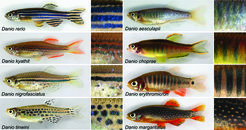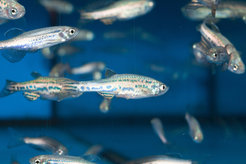Evolution of Pigment Pattern Formation in Danio Fish
Most animals are pigmented; pigmentation offers protection from harmful UV radiation or may be used for thermoregulation. However, pigmentation patterns are also very widespread, they are often used for camouflage or warning, or for intraspecies communication. Since these patterns are direct targets of natural and sexual selection, they are of great evolutionary importance. Starting from zebrafish, we investigate the genetic basis of the diversification of color patterns in the group of Danio fish.
In the last decades, zebrafish (Danio rerio) have become a very important model organism for basic biomedical research. This means that the fish are used to investigate a plethora of biological processes, and many genes are already known that are involved in the development from the fertilized egg cell to the adult fish.

Adult zebrafish have a very distinctive pattern of horizontal dark and light stripes on their bodies and the anal and caudal fins. This pattern is formed by three different types of pigment cells: melanophores, in which the dark pigment melanin is synthesized, xanthophores, which contain yellow/orange pigments, and light-reflecting iridophores. Experiments have shown that all three classes of pigment cells must be present, and communicate and interact with one another for the striped pattern to form. There are a number of mutations in zebrafish that result in defects in cell-to-cell communication; then a regular stripe pattern can no longer form, but a pattern of irregular and interrupted stripes or dots may be formed instead.
Other Danio species, very closely related to zebrafish, show an astonishingly diverse range of color patterns, also making them attractive aquarium fish that are traded and bred worldwide. There are species that also have horizontal stripes, but not quite as regularly as zebrafish (Danio kyathit, Danio nigrofasciatus). Fish of other species are spotted (Danio tinwini, Danio margaritatus), have vertical bars (Danio aesculapii, Danio chopae, Danio erythromicron) or almost no pattern at all (Danio albolineatus). This variation provides an excellent basis to study the evolution of pigment pattern formation in a closely related group of vertebrates; with the great advantage that a very well-studied model organism can be used as basis for the research.

In zebrafish we study the behavior of the cells in vivo, in the developing animal. We compare 'normal' wild type fish with mutants and with fish of other species. It is also possible to obtain hybrids between the different Danio species, and thus to identify genes whose functions have changed over the course of evolution. The rapid technical developments of recent years, especially in the field of genome sequencing and targeted genome editing with the CRISPR/Cas system, now enable us to investigate gene functions in other Danio species (non-model organisms).


